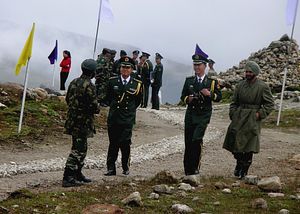The recent burning of maps by China that portrayed Arunachal Pradesh as part of India has elicited diverse opinions from different quarters on the meaning of the episode, what triggered it, and its effect on the continuing dialogue between the two countries to resolve the border row.
“Maps are the main form of representing national territory, which is serious for its political, scientific and legal significance. Problematic maps, if they appear in imported and exported products, will confuse the international community about China’s territory and the government’s position, or even be hyped by those with ulterior motives, seriously damaging national interests and the government’s image, the notice emphasized,” said the state-run daily, Global Times.
So far, 21 rounds of talks have been held between India and China to resolve the differences over the Line of Actual Control (LAC), which spans a long distance of 3,488 km mostly over hilly terrain. The last round, held in Sichuan between Indian National Security Adviser Ajit Doval and Chinese Foreign Minister Wang Yi, took place amid the backdrop of the 73-day confrontation between the two militaries at Doklam. The confrontation centered on the Chinese Army’s plan to construct a road close to India’s strategic “Chicken’s Neck,” which links seven border states collectively called the Northeast.
There are around 20 places along the LAC where the claims of both the countries overlap besides Aksai Chin and Arunachal Pradesh which China claims as its own territories. The confusion has resulted in frequent intrusions by the army into each other’s territories in the past several years.
Dialogue Will Continue
Indian diplomats are of the view that neither the burning of the maps nor the incident at the recent BRI summit in Beijing when maps showing Jammu and Kashmir and Arunachal Pradesh as parts of India were removed would impede future talks to resolve the border dispute. They point to the slew of agreements inked between the two neighbors in the past two-and-a-half decades and the Wuhan Summit last year as an indication of the improving ties despite the failure to resolve the border dispute.
“The authorities are now proactively ensuring the correct depiction of China’s boundaries as the country regards them and is imposing serious penalties on those who may be guilty of lapses, inadvertent or otherwise. China’s position remains that Aksai Chin and Arunachal Pradesh, known to China as southern Tibet, are Chinese territories; that Jammu and Kashmir is disputed territory between India and Pakistan and should be settled between them. I do not believe that the above position has changed,” said Shyam Saran, a former Indian foreign secretary.
Saran’s opinion that the burning or removal of the maps has not changed China’s position on the border is echoed by former director of the New Delhi based Institute of Chinese Studies Prof. Alka Acharya who is currently with Jawaharlal Nehru University. “They (Chinese) are extremely punctilious about their maps and did clearly not want any depiction which does not accord with their official position. There will be no impact on the ongoing dialogue. Destroying maps which did not uphold their claim does not mean they would change their position – it is only a reiteration – a logical step in keeping with their claim. They would not want anything to dilute that claim,” she said.
No Early Resolution of Border Dispute
At the same time, there are Sinologists and a section of Indian government officials who are less optimistic and doubtful of an early resolution of the border dispute between the two countries. A senior army official who was recently posted on the border in Arunachal Pradesh explained that while some intrusions by the Chinese army into Indian territory could have been “accidental,” there were other instances which indicate that they were “deliberate attempts.” He referred to an episode in 2014 when PLA troops intruded and camped in Ladakh for several days which also coincided with the visit of Chinese President Xi Jinping to India.
Some intelligence officials believe that while cooperation between the two neighbors could reach new heights in several areas in the years ahead it is doubtful if Beijing would be willing to arrive at a settlement of its border with India anytime soon. They said that China’s reluctance to settle territorial disputes is also discernible with its other neighbors like Taiwan, Japan, and Vietnam.
“It is a chauvinistic policy which harks back to the territorial claims of the last Chinese imperial dynasty, the Qing and the CCP (Chinese Communist Party) strives to gain legitimacy by shrouding itself in the robes of bygone Emperor,” explained author and prominent Sinologist Lars Ellstrom. “It is thus also a very dangerous policy. One should not expect any will to compromise from the leaders in Beijing but rather that they might act in arbitrary and impulsive ways.”
“In addition, when armed forces face each other in the field small mistakes can quickly escalate into major confrontation. As regards the shredding and burning of those maps, those actions are of course one manifestation of this assertive or chauvinistic, no-compromise, policy. I cannot and will not predict exactly what will happen but what is going on does not bode well for India, Taiwan, nor for the world.”
Rajeev Bhattacharyya is a senior journalist in Assam, India.

































